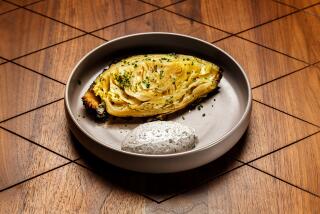Of Cabbages and Kohlrabi
- Share via
A panicked friend called the other day. “Help! On an impulse I bought kohlrabi at the farmers market, but now I realize I haven’t the faintest idea what to do with the stuff. Got any hints?”
She had been unable to resist the unusual appearance and purple color, the very characteristics that make others shy away from this vegetable. Kohlrabi is a member of the cabbage family; in fact, the German name means “cabbage turnip.”
In addition to purple, there’s a pale-green kohlrabi. Both give the appearance of being a root vegetable, but the bulbous section is actually the lower end of the stem and grows above ground. It, the stalks and leaves are all edible.
Young, small bulbs, about three inches in diameter, have the most delicate flavor. Select those with fresh-looking leaves and bulbs with the fewest blemishes or cracks.
Before refrigerating, cut off the leaf stalks at the bulb (Step 1) and wrap separately. Leaves will keep two to three days, bulbs up to a week.
To cook the leaves, wash well and drain. Strip away from the stems by folding the two sides of the leaf together and holding with one hand, then pulling from the stem with the other hand (Step 2). Trim away any discolored or bruised areas.
Blanch the leaves in boiling water two to three minutes, drain, then leave whole, slice or chop. Saute in a small amount of olive oil or butter with minced garlic and onion, if desired. Season to taste with salt, pepper and vinegar.
The bulbs may be eaten raw, peeled and sliced as a crudite , or sliced, diced or cut julienne and added to salads. Raw or steamed kohlrabi may be marinated in vinaigrette and served solo or used as a salad ingredient. It can also be simply steamed, tossed with melted butter and served as an entree accompaniment.
The diced raw vegetable may be added to soups and stews during the last half hour of cooking. Kohlrabi may also be stir-fried with other vegetables and meats or shredded and sauteed with a little minced onion and fresh herbs in olive oil or butter until tender, then seasoned with salt and pepper.
When cooking whole bulbs, opinions vary on whether they should be peeled before or after cooking. The late Bert Greene claimed peeling them beforehand promoted more even cooking and thought it a nuisance to peel hot vegetables.
We agree, but prefer using a paring knife (Step 3), rather than Greene’s recommendation of a swivel-bladed peeler. Make certain to remove all of the fibrous layer just beneath the skin.
Larger bulbs may be hollowed out, leaving about a quarter-inch shell, and stuffed with meat or vegetable mixtures. Simmer in liquid until the shells are tender when pierced, 45 minutes to an hour, depending on size. Thicken the braising liquid and serve as a sauce.
More to Read
Eat your way across L.A.
Get our weekly Tasting Notes newsletter for reviews, news and more.
You may occasionally receive promotional content from the Los Angeles Times.










